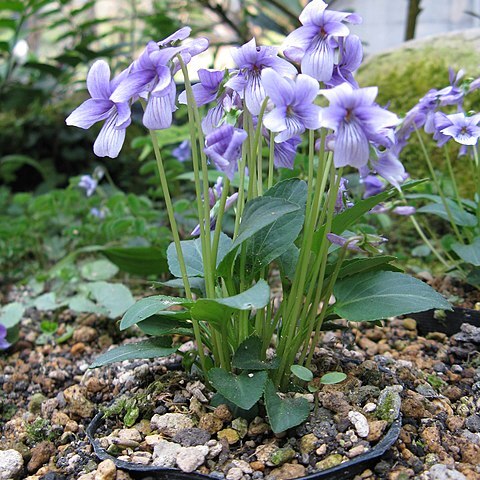Herbs perennial, acaulescent, 3-10 cm tall at anthesis, to 20 cm at fruiting. Rhizome erect, short, 4-20 cm, stout, to 9 mm in diam., often surrounded by remains of leaves of previous year in upper part; roots several, gray-white, long, robust, usually produced from lower part of rhizome, straight descending or sometimes subhorizontal. Leaves numerous, basal; stipules greenish or glaucous, membranous when dry, ca. 2/3 adnate to petioles, lower ones 7-9 mm wide, free part linear-lanceolate, 7-13 mm, margin remotely denticulate; petiole 1-5 cm at anthesis, to 13 cm at fruiting, robust, narrowly winged in upper part, glabrous or puberulous; leaf blade at anthesis oblong-ovate, ovate-lanceolate, or narrowly ovate, 1-4.5 cm × 6-20 mm, both surfaces glabrous or puberulous, sometimes hairy only along veins, base slightly cordate, truncate, or broadly cuneate, slightly decurrent, margin usually involute when young, densely crenulate, apex obtuse or ± acute; leaf blade conspicuously enlarged at fruiting, to 10 × 4 cm, triangular-ovate, broadest near middle, base usually broadly cordate. Flowers purple-violet or purplish, light colored and purple striate at throat, large, 1.2-2 cm in diam., not fragrant; pedicels angled, exceeding leaves, robust, 2-bracteolate near middle; bracteoles linear. Sepals lanceolate or ovate-lanceolate, 6-8 mm, margin narrowly white membranous, apex acute, basal auricles 1-2 mm, apex irregularly dentate or subentire, ciliate or glabrous. Upper petals obovate, 8-11 mm, curved upward, lateral ones oblong-obovate, 8-12 mm, glabrous or rarely sparsely bearded, anterior one 1.4-2.5 cm (spur included); spur 5-9 mm, 1.5-2.5 mm in diam., apex obtuse and curved upward. Appendage of connectives ca. 1.5 mm; anthers 1.5-2 mm; spur of 2 anterior stamens ca. 4.5 mm, apex acute. Ovary narrowly ellipsoid, glabrous; styles clavate, base conspicuously geniculate, thickened in upper part; stigmas flat or slightly concave, very rounded or narrowly margined on lateral sides and abaxially, very shortly beaked in front, with a smaller stigma hole at tip of beak. Capsule narrowly ellipsoid, 5-12 mm, glabrous, apex obtuse, often with persistent styles. Seeds numerous, deep brown, ovoid-globose, ca. 2 mm, ca. 1.5 mm in diam., often brown-punctate. Fl. Mar-Apr and Oct, fr. May-Sep. 2n = 48*.
More
Plants perennial, acaulescent, not stoloniferous, 3–20 cm; rhizome stout, fleshy. Leaves basal, 6–22, ascending to erect; stipules linear-lanceolate, margins remotely denticulate, apex acuminate; petiole 1–13 cm, narrowly winged distally, glabrous or puberulent; blade unlobed, oblong-ovate, ovate-lanceolate, or narrowly ovate, 1–4.5(–10) × 0.6–2(–4) cm, base usually truncate, sometimes ± cordate or broadly cuneate, margins crenulate, ciliate or eciliate, apex obtuse or ± acute, surfaces glabrous or puberulent. Peduncles 2.5–6 cm, glabrous, bracteoles near middle. Flowers: sepals lanceolate or ovate-lanceolate, margins ciliate or eciliate, auricles 1–2 mm; petals light violet or purple on both surfaces, rarely all white, lower 3 dark violet-veined, lateral 2 beardless or sparsely bearded, lowest 14–25 mm, spur pale to dark violet, elongated, 6–9 mm, tip hooked up; style head beardless; cleistogamous flowers present. Capsules narrowly ellipsoid, 5–12 mm, glabrous. Seeds dark brown, ca. 2 mm. 2n = 48.
Can be grown by divisions or seedlings. Seeds needs stratification.

